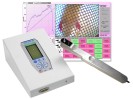Authors
del Valle, J., de la Oliva, N., Muller, M., Stieglitz, T. et al.
Lab
Dept. of Cell Biol., Physiol. & Immunology, Univ. Autonoma de Barcelona, Bellaterra, Spain
Journal
Neural Engineering (NER)
Abstract
For assessing the suitability of a given material for peripheral nerve implantation, acute and chronic tests to investigate tissue reaction, and evaluate the thickness of fibroblast layers that surround the material and the presence of inflammatory cells are mandatory. In this study we compared in vivo the biocompatibility of parylene C and polyimide, two materials intended for fabrication of neural electrodes. We have tested these two materials after implantation of thin devices in the peripheral nerve of rats, by functional and morphological methods, assessing thickness of the fibrotic capsule, signs of inflammation and axon survival in areas close to the implant. Intraneural implantation of parylene C and polyimide devices did not produce any functional alteration in the sciatic nerve, as evidenced by electrophysiological, locomotion and nociceptive functional tests. The intraneural devices were encapsulated within a fibroblastic tissue. Resolution of the inflammatory infiltrate took 4-8 weeks. In conclusion, both parylene and polyimide electrodes show biocompatible characteristics and induce a similar fibrotic reaction after chronic intraneural implantation.
BIOSEB Instruments Used:
Electronic Von Frey 4 (BIO-EVF4),Electronic Von Frey 5 with embedded camera (BIO-EVF5)

 Pain - Thermal Allodynia / Hyperalgesia
Pain - Thermal Allodynia / Hyperalgesia Pain - Spontaneous Pain - Postural Deficit
Pain - Spontaneous Pain - Postural Deficit Pain - Mechanical Allodynia / Hyperalgesia
Pain - Mechanical Allodynia / Hyperalgesia Learning/Memory - Attention - Addiction
Learning/Memory - Attention - Addiction Physiology & Respiratory Research
Physiology & Respiratory Research
 Pain
Pain Central Nervous System (CNS)
Central Nervous System (CNS) Neurodegeneration
Neurodegeneration Sensory system
Sensory system Motor control
Motor control Mood Disorders
Mood Disorders Other disorders
Other disorders Muscular system
Muscular system Joints
Joints Metabolism
Metabolism Cross-disciplinary subjects
Cross-disciplinary subjects SFN2024: Meet our team in Chicago on booth #876
SFN2024: Meet our team in Chicago on booth #876 
